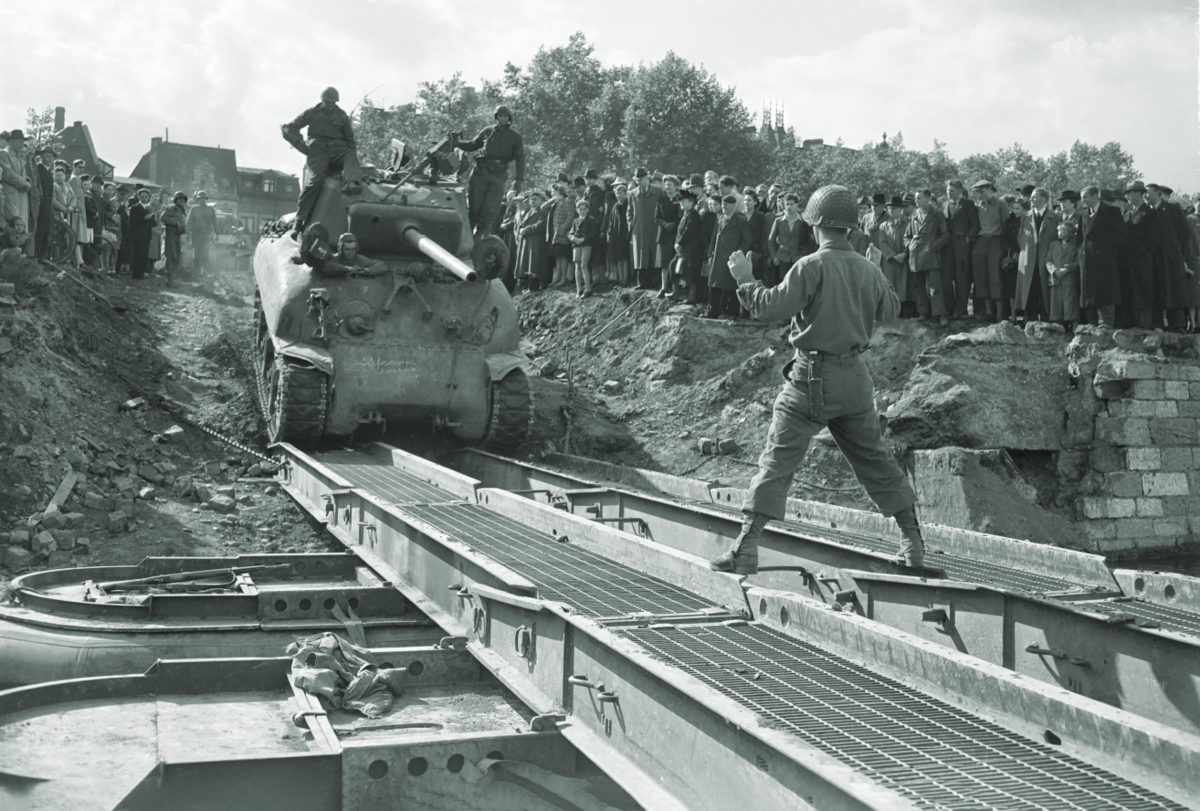The directive took Staff Sergeant Lafayette G. Pool aback. For weeks, his olive-drab Sherman M4A1 medium tank, its sides painted in white block letters with the name In the Mood, had been in the lead position—the spearheader—for the 3rd Armored Division. But orders were orders.
They came from a fellow Texan, an equally bold man whom Pool respected, Lieutenant Colonel Walter B. Richardson, the commander of the 3rd Armored Division task force to which Pool’s battalion belonged.
“No spearheading today, Pool,” Richardson announced. It was September 19, 1944. The first rays of sunlight began to illuminate the silhouettes of dozens of tanks clustered in his bivouac area near Aachen, in western Germany. “You guys are heroes, and I want you going home to mama safe and sound. You take the flank.”
Pool, a powerful man of six foot two with dark brown hair and sloping shoulders, looked hurt. Since his 32nd Armored Regiment had come ashore on the beaches of Normandy in late June, his tank crew had proven themselves time and again. By late that year the U.S. Army would conservatively credit In the Mood’s crew with the destruction of at least 275 enemy vehicles (including at least six German tanks), 250 enemy soldiers captured, and some 1,000 enemy soldiers killed or captured. In the three-day span of August 29 to 31 alone, they had been credited with the destruction of four German tanks, three antitank guns, and approximately 50 armored vehicles.
Senior officers were already in the process of writing up Pool for the Distinguished Service Cross, the nation’s second-highest military honor. Pool wondered momentarily what compelled his superior to hold them back now as they pushed into Germany.
Then Richardson explained. America needed heroes back home to support the war effort. Pool and his four-man crew fit the bill. He was a bona fide tanker ace, and his crew’s reign of destruction exceeded that of any other five-man group in the 3rd Armored. Classified as a “heavy” division because of its large size and nicknamed the “Spearhead” Division, the 3rd Armored would see extensive action throughout Europe. Plans had been drawn up to ship In the Mood’s crew back home around the first of October to conduct a war bonds tour and give speeches to rally American support for the war in Europe. Before heading home, though, Pool and his unit were to finish the push through Aachen, deeper into the heartland of Germany. It was an important drive that day, one that Pool’s crew would never forget.
The celebrated Texan tanker came from humble beginnings. Lafayette Green Pool was born on July 23, 1919, just five minutes after the birth of his twin brother, John Thomas Pool. The boys were raised in the small farming community of Odem, Texas, 20 miles from Corpus Christi and the southern Texas coast. As they grew older, the twins were sometimes called “L. G.” and “J. T.,” but Lafayette often went by “Lafe.”
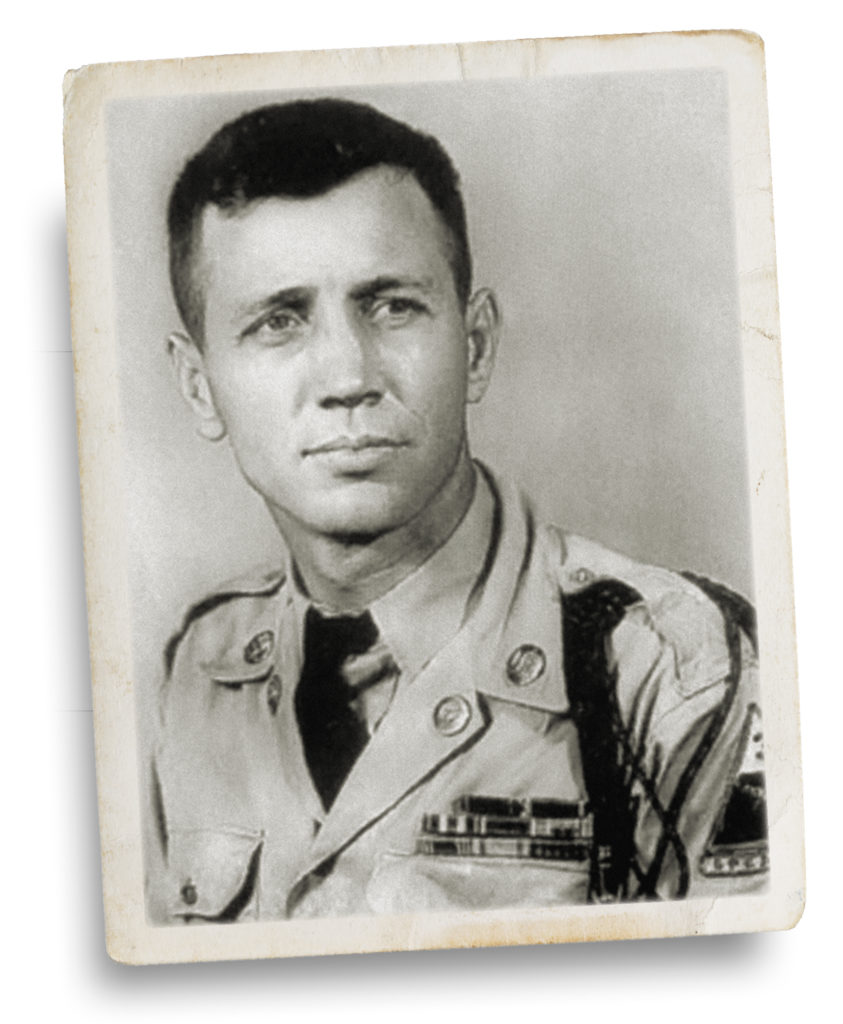
Upon graduation from high school in 1937, where Lafe was a star football player, he and John decided to enlist in the U.S. Navy. The older brother was accepted, but an eye injury Lafe had sustained at age five got him turned away. Instead, he enrolled in an all-boys Catholic prep school in Corpus Christi, graduated as class valedictorian in 1938, and began pursuing an engineering degree at the Texas College of Arts and Industries in Kingsville.
To help pay for his education, Lafe Pool worked as a foreman on his father’s farm and took up boxing, earning cash prizes for winning matches. He continued to hone his skills in the Golden Gloves amateur league, but never lost sight of the military. When the national draft was instituted in September 1940, Pool enlisted in the U.S. Army, faking his way through the required vision test by memorizing the eye chart before his exam.
In January 1942, Pool joined the 32nd Armored Regiment’s I Company and quickly worked his way up to tank commander with the rank of sergeant. He continued boxing, his nose crooked from his many bouts, becoming regional champ in his weight class and winning all 41 of his matches. A victory in a February 1942 match earned Pool a spot at the Golden Gloves championship in Chicago, but he declined in order to master the latest M3 tank variant his division had just received. Duty clearly came first.
After extensive training, Pool and his 32nd Armored Regiment boarded troopships in New York and, in September 1943, began the journey toward the European Theater. The 3rd Armored Division staged and trained in England, where Pool even managed to jump in the ring in spring 1944 for an exhibition match with the world heavyweight boxing champion, Joe Louis. Against the “Brown Bomber,” Pool suffered his first loss. Although not knocked out, he later admitted that Louis turned him “every which way but loose.”
Less than two months later, on June 23, 1944, Pool and his regiment went ashore at Normandy to experience a different style of fighting. His first In the Mood Sherman—the name coming from a popular Glenn Miller Orchestra release—was knocked out six days later by a German Panzerfaust rocket that killed one of his crewmen.
Pool then became the first tank commander in his regiment to be assigned the new M4A1(76)W Sherman variant, which sported a more lethal 76mm main gun. In late July his crew knocked out their first German Panther tank—the beginning of their string of successes. That In the Mood survived until August 17, when it was disabled by bombs dropped by an American Lockheed P-38 Lightning as Pool’s platoon was clearing German forces near the village of Fromental, France.
Equipped with another M4A1(76)W in late August, the In the Mood crew was called on to assume the role of spearheading—taking the dangerous, most-forward position—as the 3rd Armored Division, on September 1, 1944, began advancing through Belgium and toward the German homeland.
Pool’s crew was solid, having regularly outscored other division crews in gunnery efficiency. That teamwork paid off against German armored forces in the 21 drives In the Mood led in August and early September. His driver was red-haired, 24-year-old Technician Fifth Grade Wilbert Richards, whose baby-faced looks earned him the nicknames “Bunny” and “Baby.” Behind the wheel of his Sherman, Richards was all business. “He could have parallel-parked that big Sherman in downtown New York in rush hour traffic,” Pool remembered.
His bow gunner and assistant driver, Corporal Bert Close, 19, was vicious in combat with his .30-caliber machine gun. Sporting wire-frame glasses, Close had been dubbed “School Boy” by Pool. In the Mood’s 76mm gunner was a 29-year-old from Illinois, Corporal Willis “Groundhog” Oller, whose perfectly placed shots had knocked out one German Panzer V Panther and Mark IV tank after another. Through each of their fights, Oller had been assisted by skinny-but-strong shell handler Technician Fifth Grade Delbert Boggs, 22, from West Virginia.
Although Lafe Pool was younger than two of his crewmen, they called him “War Daddy”—a nod to a man burning with desire to be in the forwardmost position when engaging enemy forces. “He was confident of himself, and his attitude was good for us all,” Close recalled. They were stunned along with Pool when Lieutenant Colonel Richardson passed his orders to the team that they would soon be heading home on a war bonds tour.
The men expected the push deeper into Germany that September 19 to be contested. Between July 26 and September 2, the 3rd Armored Division had covered nearly 300 miles, fighting across France and Belgium. Roughly two-thirds of the division’s 232 M4 Shermans had been disabled at least once and replaced or repaired along the way. The Spearhead Division had then pushed forward another 110 miles toward the historic German city of Aachen and Germany’s fortified “West Wall”—a defensive line of bunkers and concrete barriers along its western border known to the Allies as the Siegfried Line.
During that time, crowds of cheering Belgian citizens had handed out chocolates, flowers, and bottles of booze to the first American soldiers they had seen. “I believe that I tasted every drink concocted coming through France and Belgium,” Bert Close wrote to his parents.
En route to the town of Stolberg, six miles east of Aachen, In the Mood and other tanks penetrated the rows of concrete barriers called “Dragon’s Teeth.” During a three-day span, some 79 other Shermans, plus many more scout cars and half-tracks, had been hit and burned out while busting through the West Wall.
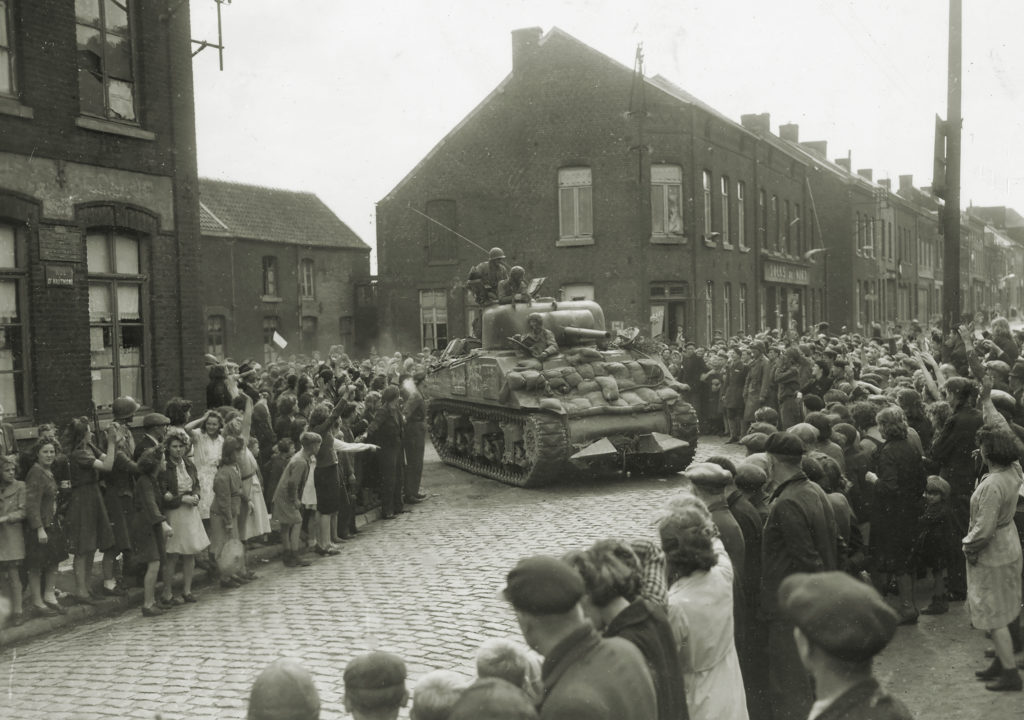
Lieutenant Colonel Richardson, the task force commander, was slated to oversee the push into Stolberg. The 1st Battalion of the 36th Armored Infantry Regiment would move out at 6:30 that morning to attack Münsterbusch, a western district of Stolberg, with the 3rd Battalion of the 32nd Armored Regiment, Richardson’s usual command, operating in direct support of the infantry.
Not only was In the Mood not in the lead that day, but Pool’s loader, Del Boggs, was not with them. In preparation for the coming war bonds tour, he had been ordered to the medical station for a hearing test and dental work prior to shipping home. Although it wasn’t stated directly, some thought he was being pulled for his own safety; his brother Charlie, who’d been in the same company as Del, had been killed in action two months prior, and Richardson certainly did not want to explain to Mrs. Boggs how he had lost both of her sons just before the second was to return home.
That meant Pool was without the full-time loader who normally would have kept Groundhog Oller’s 76mm cannon firing without a pause. His bow gunner, Bert Close, had often helped pass ready ammunition to Boggs and Oller; now he’d have to serve as the primary loader. As Baby Richards maneuvered In the Mood behind several other Shermans, Close crawled out of his assistant driver’s seat in the tank’s right front and took a seat below Oller.
At 3 p.m., Richardson ordered the task force to attack enemy forces at Münsterbusch. The Germans were heavily fortified with antitank guns, heavy artillery, and mortar platoons. On top that that, word arrived shortly later from the 83rd Armored Reconnaissance Battalion that four Panther tanks were moving about the area. At any time during the prior month, Lafe Pool would have ordered Richards to push their tank forward toward the heart of the enemy’s position. Instead Pool reluctantly watched two other I Company Shermans advance toward Stolberg to sniff out the Panthers ahead of him.
As Pool and the 3rd Platoon moved forward, they came under intense enemy fire. The forwardmost Sherman, in the spearhead position—an H Company tank—was struck by a German shell that killed or wounded four of the crew. Tank and artillery fire quickly suppressed this opposition, and by 4:30 the task force had broken through and continued into Stolberg. They advanced into the Münsterbusch area by 6:15 with a force from the 16th Infantry Regiment, 1st Infantry Division, that had been positioned just outside Aachen.
Just before they reached Stolberg, a set of natural and manmade obstacles halted forward movement. Ahead lay a deep gully, with a set of railroad tracks along its side. It reminded Bert Close of a similar draw back home in Portland, Oregon. With the 3rd Platoon held up, First Lieutenant Edward Mangan, who had assumed command of I Company when its previous commander had been killed in late August, ordered the leading tank crew to reconnoiter the terrain for the safest point to cross. Then an I Company jeep came racing up from the rear. It screeched to a halt near Pool’s tank. As the dust settled, a young soldier hopped out and walked up to In the Mood.
Private First Class Paul Kenneth King, 20, from Anderson County, Tennessee, told Pool, “I’m your loader for the day.” Pool invited the young man to climb aboard and assume the position as Oller’s shell loader. A relieved Close scrambled back into his usual assistant driver’s seat alongside Richards. As King was introduced to the crew, Mangan received word from his scout team that a crossing point through the ravine had been located.
“Okay, Bunny, move out!” Pool called to Richards.
Richards put In the Mood in gear and followed the procession of Shermans across the gorge. Back in his bow gunner’s seat, Close closed his upper hatch and raised his periscope; with word that four German Panthers were roaming about Stolberg, he decided that discretion was the better part of valor. Pool and Oller, standing in the turrets and peering through open hatches, chose otherwise as they scanned the terrain ahead. Trailing the procession with his light tank company of M3 Stuarts, Captain Olin Brewster spotted Lafe Pool in his typical command position—hatch open, standing half exposed as they drove forward.
War Daddy was primed for action. As I Company’s leading elements advanced through the ravine, Pool’s platoon came under fire from a well-hidden enemy on their right. In the heat of the action, no one was certain whether the incoming 88mm shells had come from a German tank or an antitank gun.
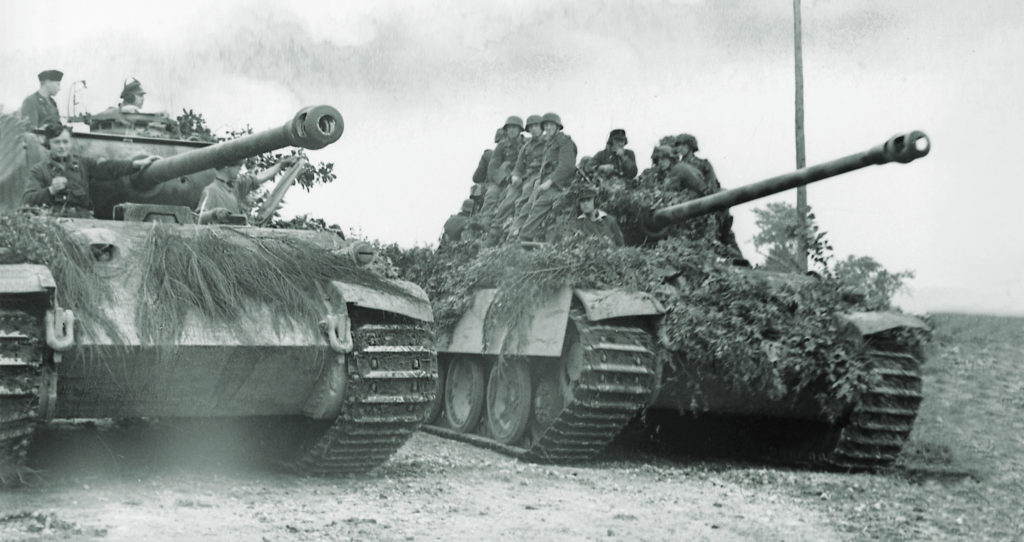
It didn’t matter. Pool’s tank and those ahead of him were caught without warning in the German gunners’ crosshairs. The first barrage struck a nearby H Company tank. Pool shouted at Oller to take a shot. In the Mood’s regular loader, Del Boggs, had never missed a beat, but his replacement struggled to quickly load his next shell.
Pool sensed that his gunner was unable to fire as quickly as needed. He wasn’t about to wait for the Germans to unleash another round.
“Back her up, Baby!” he hollered.
Richards shifted In the Mood into reverse, but before he could back up, the German antitank crew found its mark. A shell slammed into the front of the tank’s turret near where Pool and Oller were standing. To Pool, it sounded like a cathedral bell as the round passed through the turret and out the back side as if it were constructed of tissue paper.
The path of destruction was devastating. The shell and shrapnel from the explosion hit the ammo racks, and a scrap of shell hit King in the head. It also sliced through Oller’s left leg and, behind him, through Pool’s right leg. The force of the explosion blew Pool out of the hatch. He hit the ground and tried to get to his feet, but his leg was nearly severed. He collapsed as the limb gave way under his weight.
When Oller came to, he was on the ground about 20 yards behind the tank, having bailed out or been blown out of his hatch by the explosion; in the fog of pain and shock, the previous seconds were little more than a blur. He felt warm blood on his leg and looked down. His left leg was ripped open just above the knee, with bone and tissue exposed as blood spurted from the wound.
Inside In the Mood, two of his comrades were still alive. Richards and Close slammed their hatches open, ready to evacuate if the Sherman went up in flames and threatened to detonate the ready 76mm ammunition. Close turned around and saw his new loader slumped on the floor. King wasn’t moving. The round that caught him in the head had killed him instantly. Without Pool or Oller’s vision above to guide him, Richards drove In the Mood straight backward, hoping to get out of range of the weapon locked onto them.
But the tank reversed just a few yards before another round rocked it. The shell ripped through the M4A1 in almost the same place—although once again the lives of Close and Richards were spared. Since their tank was not yet ablaze, Richards kept moving swiftly backward. Oller looked up to see the Sherman surging toward him and somehow managed to roll his body out of the path of its churning tracks.
Baby Richards’s blind retreat was short-lived. At the edge of the ravine, In the Mood lurched as its treads encountered a large crater. Richards and Close were slammed against the tank’s steel interior as it rolled onto its side and flipped upside down, coming to rest three-quarters overturned. There was just enough space for Richards and Close to crawl out of their escape hatches. As the German gun continued to fire and other Shermans issued high explosives in return, the pair scurried underneath their vehicle to take cover.
Earth and vegetation blasted skyward as a heavy German artillery barrage chewed up the area around three shattered American tanks. In the midst of the pounding, Richards and Close crawled back into In the Mood. Together, they wrestled King’s body through one of the hatches and laid him on the ground underneath their Sherman.
Richards eventually escaped toward the rear of the carnage; Close remained huddled under In the Mood. For more than 45 minutes, gunfire and artillery exchanges continued, some of the blasts close enough to keep him in place.
Nearby, Oller and Pool lay badly wounded, bleeding profusely from their mangled legs. Pool managed to give himself a shot of morphine for the pain, then tried to cut away the ruined portion of his right leg with his own pocketknife. He gave up as Lieutenant Colonel Richardson jumped from his tank and ran to him. Richardson administered a second shot of morphine and shouted for medics.
Two corpsmen braved the enemy fire to reach Pool. They quickly wrapped his leg, then one of them gave him a third shot of morphine, unaware that Pool had already given himself a dose. He was drifting off into unconsciousness as they strapped him to a litter. Before his eyes closed, Pool muttered, “Somebody take care of my tank.”
Other medics made their way to Oller, pulled him from the firefight, administered morphine, and began working on his left leg. He and Pool were then hustled toward the rear lines to an aid station.
When Bert Close finally emerged from under the tank, I Company and their opponents were still exchanging rounds. Steeling himself, he sprinted back several hundred yards to the task force’s forward command post. As he arrived, he heard several officers speaking to a group of war correspondents.
“Sorry we don’t have much news up here for you,” one said.
Close was incensed. I could gladly show them a place where they can get some news! he thought.
As evening approached, he moved back a few miles to the bivouac position where his company headquarters had been that morning. He then discovered that the only wound he had suffered during the loss of In the Mood was a cut lip, sliced open by a shard of shrapnel from the second shell. It would serve as his only physical reminder of the losses his crew had endured on September 19.
All of the meaningful keepsakes Close chose to carry with him in battle—and those of Pool, Oller, and Richards—had been destroyed by the explosions. Close would later mourn the loss of the gold signet ring that had once belonged to his grandfather and a small leather cigar case another ancestor had carried through the Crimean War. But he and Richards counted their blessings. The second direct hit to their tank could have been their last.
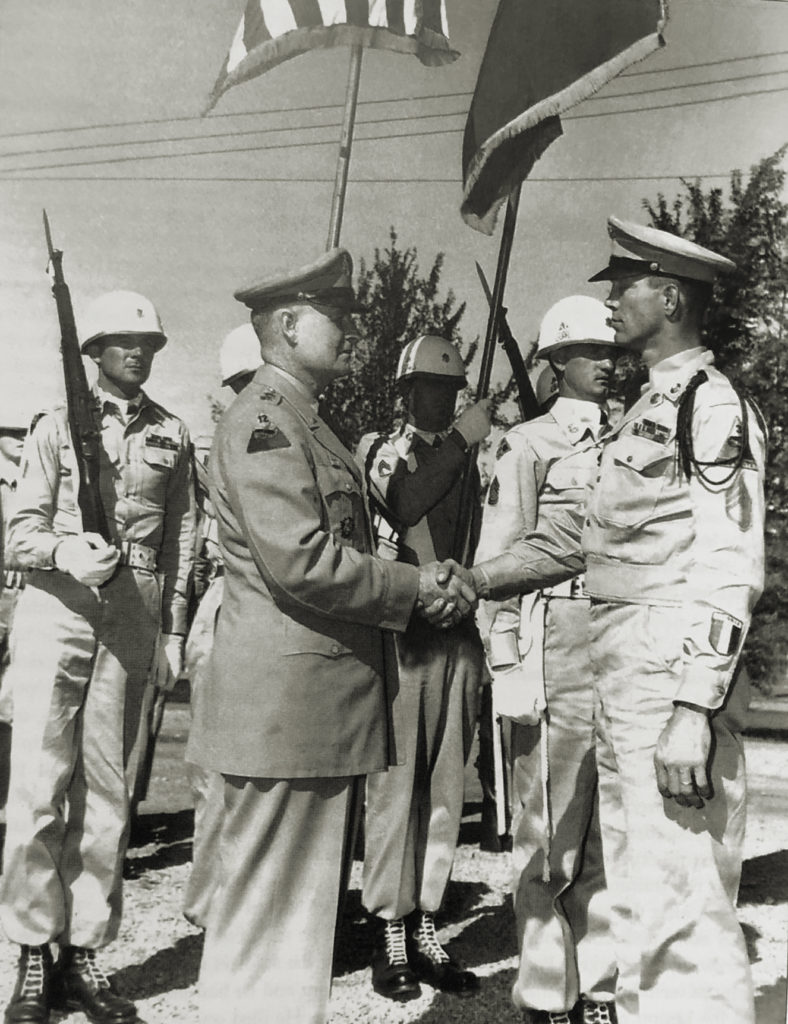
Both men would return to the European battlefields. But for War Daddy Pool and Groundhog Oller, their only fight for the time being was to remain alive.
There would, of course, be no war bonds tour for the In the Mood crew. Richards and Close continued with the 3rd Armored Division. Del Boggs also remained in service and was reassigned to the 474th Air Service Group, 9th Air Corps, and rose to the rank of corporal before departing the European Theater in July 1945. Willis Oller spent 14 months in various hospitals before he was discharged from the army’s O’Reilly Hospital in Missouri. Six surgeries helped save his left leg, and he left service on February 15, 1946, wearing a special brace and shoe.
In the two years following his final battle in Germany, Lafe Pool—who would eventually be pinned with numerous campaign service medals and personal valor medals, including four Bronze Stars, the Legion of Merit, the French Croix du Guerre, and the Distinguished Service Cross—was treated in a series of hospitals. His right leg was eventually amputated eight inches above the knee, but the resilient Golden Gloves fighter was fitted with a prosthesis and returned to the army in 1948 for three more years as a tank park supply and dispatch sergeant in the 3rd Armored Division’s Combat Command B. He rose to the rank of Chief Warrant Officer Second Class, and retired from service in 1960.
Pool’s character was roughly translated to film in Warner Brothers’ The Tanks are Coming in 1951. Decades later, actor Brad Pitt played the role of World War II Sherman tank commander “War Daddy” Collier in the 2014 film Fury. Although the movie was fictional, the name of Pitt’s aggressive character was an obvious reference to the army’s most famous tanker.
“There were no heroes, no Rambos. We were a team,” Pool remarked during a 1988 visit to Fort Hood, Texas. “Every medal I received, it wasn’t me. It was my team.” Asked for his advice to modern soldiers, he added, “Learn to survive. Shoot to kill and always go forward. Never retreat.”
Two years after his death on May 30, 1991, a new tank driver training simulator hall at Fort Knox was named in Pool’s honor. At the dedication, Lieutenant Colonel Olin M. Brewster, who served in the 3rd Armored Division with Pool and remained his friend until Pool’s death, gave a speech honoring him. Lafayette G. Pool was, he said, the “ace of tankers.”

